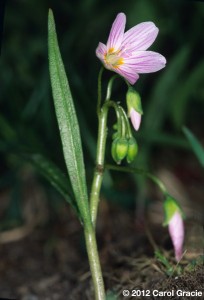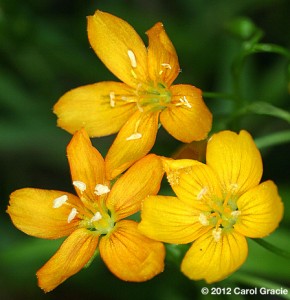Spring Beauty: Hidden in Plain Sight
Posted in Around the Garden on April 26 2013, by Carol Gracie
After spending nearly three decades at the NYBG, and working much of that time in South American rainforests with her husband, Scott A. Mori, Carol Gracie has returned to one of her first botanical interests in retirement–local wildflowers. She is the author of Spring Wildflowers of the Northeast: A Natural History and coauthor (with Steve Clemants) of Wildflowers in the Field and Forest: A Field Guide to the Northeastern United States.

Of the many spring ephemerals cropping up in the Garden, the plant known as “spring beauty” in the genus Claytonia is one that can be seen without taking a walk through the woods. It is commonly found at the edge of woodlands, or along mowed roadsides. Like many spring ephemerals spring beauty flowers close at night and remain closed on overcast days. This tendency, combined with the plant’s grass-like leaves, make it easy to miss spring beauty if you do not look closely.
The beauty of spring beauty is best enjoyed by looking closely at the flowers with a hand lens. This allows you to appreciate the delicate pink lines that lead insect visitors to the source of nectar at the base of each petal. Insects–among them small bees, flies, and wasps–are further guided to the nectaries by a bright yellow spot; they are attracted by both nectar and pollen. The tiny flowers do not produce enough nectar to warrant a visit by the large queen bumblebees that fly in early spring, but small bees drink their fill and pack their pollen baskets with the anthers‘ creamy white pollen. The anthers themselves are pink and open before the female reproductive parts, thus helping to promote cross-pollination.
[Not a valid template]
The pink-lined petals have a background color of white or pink, but in some instances they are pale yellow as in a form called Claytonia virginica forma lutea, which is occasionally found in Pennsylvania and Maryland. A variety with bright yellow petals, orange nectar guides, and white anthers is found in a limited range in New Jersey. Known as C. virginica var. hammondiae, it grows in exceptionally wet areas.

The name of the genus, Claytonia, was bestowed on the plant by Linnaeus to commemorate John Clayton, a clerk of the court in colonial Virginia. Clayton was an avid plant collector and sent many of his collections to a contemporary English naturalist, Mark Catesby, who he had befriended during Catesby’s exploration of North American natural history. Many of Clayton’s collections found their way to Linnaeus, who published descriptions and names of 400 new species based on them in his landmark work, Species Plantarum, including Claytonia virginica.
More information about this species and other wildflowers can be found in my book, Spring Wildflowers of the Northeast: A Natural History, available at Shop in the Garden. Don’t miss seeing native wildflowers in bloom at the new Native Plant Garden’s Grand Opening, May 3-5, 2013.

